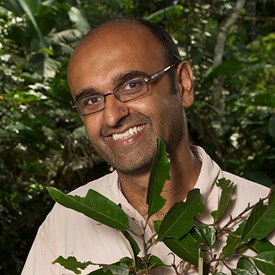To mark Biodiversity Day 2020, Professor Yadvinder Malhi explains what biodiversity is and why it matters.

Our planet is home to bewildering assemblages of life. Millions of different kinds of animals, plants, bacteria, and fungi coexist in remarkably interconnected ways. Together they make up the biodiversity of the Earth. Professor Yadvinder Malhi, an ecosystem scientist at the University of Oxford and Fellow of the Royal Society, explains what biodiversity is and why it matters.
What is biodiversity?
In its broadest sense, biodiversity is made up of all living things on our planet. It encompasses the full spectrum of life on Earth that has been shaped by billions of years of evolution, from the smallest bacteria to the largest plants and animals, including our own species.
When we try to define biodiversity more formally, we can look at it in many different ways.
Most commonly it is used to describe the variety of species we might find in a habitat or given area, but it also refers to how communities of species interact with each other within ecosystems and with the physical environment itself.
Biodiversity can also include the variety of ecosystems that can occur in an environment, such as different types of forest or wetland, or mosaics of habitats. The size of the ecosystem can vary too – it can be the leaf litter that blankets the floor of an entire forest, or a section of coral reef in an ocean or a pond in your back garden. All of these have biodiversity that is crucial for maintaining that environment in the way it is.
We can also find biodiversity at a molecular level – between the DNA of individuals within a species. Genetic diversity within species determines how unique each individual is from another and is as crucial for functioning ecosystems as having a wide variety of different flora and fauna.
How much biodiversity is there on Earth?
Scientists have spent hundreds of years collecting, counting and documenting the life on Earth. Each year we discover thousands of new species and have a catalogue of 1.6 million or so that have been so far described by science, but scientists believe we have barely scratched the surface.
One estimate suggested that we have yet to discover around 86% of the species we currently share our planet with. While we have a reasonable idea about the number of species of relatively large animals, like mammals, there could still be more of these to be found. When it comes to the invertebrates, we still only know a fraction of what exists. When we consider microbes, we haven’t even got a clear idea of what biodiversity means at those levels because of the way genetic information can be transferred between organisms.
Much of this undiscovered life is likely to be high in the canopies of tropical rainforests, or hidden in the soil or in the deep ocean and sediments there.
Why is it important to maintain biodiversity?
Biodiversity is the inherited wealth of four billion years of evolution on planet Earth, of which humans are only a recent addition. I would suggest that we need to approach it with humility – life has been around a lot longer than we have, and we are now the stewards who have a responsibility towards it. But biodiversity is also essential for human wellbeing. Without a wide range of animals, plants and microorganisms, we cannot hope to have the healthy ecosystems that we all rely upon to provide us with a wide and surprising range of services.
What value does it have for humans?
There are lots of ways that we depend upon biodiversity and it is important for us to conserve it. Agriculture, for example, is incredibly reliant upon invertebrates – they help to maintain the health of the soil crops grow in while many fruits, nuts and vegetables are pollinated by insects. Without bees we wouldn’t have apples, cherries, blueberries, almonds and many of the other foods we love on our supermarket shelves. Pollinators such as birds, bees and other insects are responsible for a third of the world’s crop production. Soil is also teaming with microbes that are vital for liberating nutrients that plants need to grow, which are then also passed to us when we eat them. In the oceans, fish and other forms of sea life provide the main source of animal protein for around one billion people.
Biodiversity can also keep us safe. Trees, bushes and wild grasslands play an important role in helping to protect us from flooding by slowing down water and helping soil to absorb rainfall. Plants and trees also clean the air we breathe and can help us tackle the global challenge of climate change by absorbing carbon dioxide. Coral reefs and mangrove forests act as natural defences protecting coastlines from waves and storms.
Many of our medicines, along with other complex chemicals that we use in our daily lives such as latex and rubber, also originate from plants. And we must not overlook the basic improvements in human health that come from spending time in a diverse natural world. There is a growing body of literature on the relationship between human health and biodiversity. Simply having green spaces and trees in cities has been shown to decrease hospital admissions, reduce stress and lower blood pressure.
Are we losing biodiversity?
Globally there is no doubt that biodiversity has been in decline and that loss is intensifying. The latest IUCN Red List reports that more than 28,000 species – nearly a third of all those assessed – are now threatened with extinction. Some of the hardest hit groups are amphibians, reef-building corals, conifer trees, sharks and mammals. And there are of course many more that we don’t know about. A recent study indicated that one million species could be threatened with extinction. Some scientists are now warning that we are on the brink of the Earth’s sixth mass extinction on the scale of those that wiped out the dinosaurs. However, there is much we don’t know about how sensitive biodiversity really is to climate change.
How do scientists measure biodiversity?
Biodiversity can be measured in a variety of ways – scientists use different sampling techniques depending on the organisms of interest. For the big animals, plants and ecosystems, we have well established measures of biodiversity such as the Living Planet Index and the Intergovernmental Science-Policy Platform on Biodiversity and Ecosystem Services (IPBES) Global Assessments. In places like Europe there are records from scientists and amateur naturalists going back hundreds of years that also help us judge how biodiversity has been changing. For smaller animals such as invertebrates and microbes, we have much less of an idea about how these populations may be changing.
But we are able to compare surveys of insects from the 1970s and 1980s to what we have now. These are starting to confirm what many of us probably suspect from anecdotal evidence – that there are fewer insects around. One study in Germany showed there has been a 75% fall in flying insects over the past 27 years while another suggested that 40% of the world’s insects may be threatened with extinction.
What are humans doing to cause biodiversity loss?
Human actions have resulted in multiple changes to the natural environment, which has had a detrimental impact on biodiversity. Several interacting drivers have caused this decline in biodiversity. Probably the most important is land use change, specifically the conversion of natural habitats into landscapes that are used intensively by humans. In tropical rainforests, for example, there is a direct loss of habitat as trees are chopped down to make way for farmland, mining and other industrial infrastructure. The loss of green space to make way for urban areas is also a contributor but relatively small by comparison. In post-industrialised countries like the UK and the US, while the direct loss of land is relatively small, the intensity with which the landscape is used has been changing. Industrialised agricultural practices and the use of pesticides, for example, have been driving declines in insects and birds.
Landscape change not only destroys the habitat where the species lives, but also fragments it, leaving species that were once widespread clinging on in tiny scattered pockets. If they are too far apart, then the gene pool for those species can become so restricted they can eventually die out. Remaining habitats can also be degraded by pollution making them less suitable for species.
Hunting for bushmeat and food is another pressure that is threatening a lot of animals. The introduction of foreign, or invasive, species onto islands has also caused huge amounts of biodiversity loss across the planet in the past. This has probably been going on since humans first started colonising islands and bringing animals like rats and cats with them from the big continents that the local wildlife was not adapted to deal with.
The spread of disease and pests are also a problem, particularly among plants. The mass movement of goods and people between far flung locations allows them spread much more quickly. More than half of Europe’s endemic trees are now threatened with extinction, mainly as a result of disease and pests. Ash dieback, which is currently cutting swathes across Europe at the moment, is a good example of this.
Now we are also seeing the effects of climate change on biodiversity, as we recently outlined in the 2018 US-UK Science Forum. Climate change will exacerbate existing drivers of biodiversity loss. As the climate warms, habitats will change and species may have to move accordingly to new areas. Species in fragmented habitats or hot or elevated areas will be particularly vulnerable. Ocean acidification as a result of increased carbon dioxide levels is damaging to many reef-building corals and other marine life.
What are biodiversity hotspots?
There are multiple definitions, but they are essentially areas that have high levels of biodiversity and are threatened by human activities. These can be local areas that have rich diversity or are internationally important because they have flora and fauna found nowhere else on the planet, such as Madagascar.
How can we conserve biodiversity?
There are a range of things we can do. We could improve the governance and protection of areas like biodiversity hotspots. We could also provide alternative pathways for economic development that help people find value in the natural areas around them. Ecosystems provide services in terms of water and carbon storage, so we need to persuade people to recognise the value in having a forest outside their city to protect them from flooding, for example.
One area close to my own heart is restoring biodiversity rather than simply protecting it. When we look at the UK, we're an incredibly biodiversity-poor country because of the loss of natural habitats that has been taking place over hundreds, if not thousands of years. But there are many opportunities to restore the levels of biodiversity it once had.
It will require us to think about ways of farming less intensively and by having more natural habitats through returning marginal farmlands into semi-natural ecosystems and planting hedgerows, we can help reverse this decline. I visited the Knepp Estate in Sussex recently where the owners found they could not make money and so decided to stop farming, allowing the land to rewild. I was astonished by the abundance of birds and insects. It was a sensation that is very rare in the British countryside now. And I think that we need to start doing this in places like Europe at the same time as we work with people in the tropics to preserve their wildlife and natural habitats. I spent much of my career trying to find ways to identify incentives to preserve tropical forests like the Amazon.
One approach that has been talked about for decades, but is hard to implement, is making payments to people living in tropical ecosystems to conserve forest rather than cut it down to make way for cattle ranches.
There is some truth to the argument that we need to look much more at our own domestic landscapes to bring biodiversity back if we want to encourage others to preserve their own rich biological diversity.






